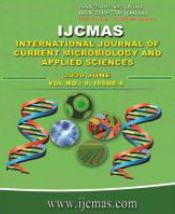


 National Academy of Agricultural Sciences (NAAS)
National Academy of Agricultural Sciences (NAAS)

|
PRINT ISSN : 2319-7692
Online ISSN : 2319-7706 Issues : 12 per year Publisher : Excellent Publishers Email : editorijcmas@gmail.com / submit@ijcmas.com Editor-in-chief: Dr.M.Prakash Index Copernicus ICV 2018: 95.39 NAAS RATING 2020: 5.38 |
This field experiment was conducted during the kharif season of 2014 and 2015 at the Indira Gandhi Krishi Vishwavidyalaya, Raipur (C.G) to find out the appropriate crop arrangement and fertility levels for maize and soybean intercropping system. Treatments comprised of six cropping arrangements viz. sole maize (C1), sole soybean (C2), two replacement series (2 maize + 2 soybean, C3 and 2 maize + 4 soybean, C4), two additive series (two rows (C5) and one row (C6) of soybean planted in-between two rows of maize and four fertility levels viz. 125% recommended dose of fertilizer (RDF) (F1), 100% RDF (F2), 75% RDF (F3) and 50% RDF (F4). Recorded SPAD value of maize and soybean leaves followed an increasing trend from 20 DAS to 60 DAS then after values decreased. Highest chlorophyll content were recorded at 60 DAS. In scenario of crop arrangement significantly higher total chlorophyll content was observed under 2:4, maize + soybean row arrangement in maize crop throughout the crop period while in soybean, sole soybean performed the highest value of this trait. Result showed higher SPAD value was observed with increasing fertility level and the treatments with 125% RDF showed significantly higher value of chlorophyll content among rest of the nutrient level.
 |
 |
 |
 |
 |